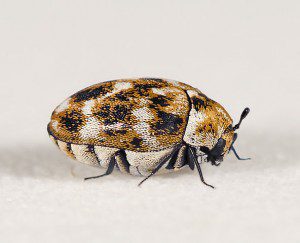Carpet Beetles Are on the Move!
By Chris Williams on March 16, 2016.

The adult varied carpet beetle
Our customers are starting to phone in about tiny, dark beetles crawling up their walls. Early every spring, adult carpet beetles make their appearance, responding to a primal urge to get outside to reproduce.
As larvae, carpet beetles shun light but once they turn into adult beetles, they head towards lights and windows (they can fly, too). You might find them dead on windowsills (see Carpet Beetles – Tiny, Dead Beetles on Windowsills). Most low-level carpet beetle infestations go unnoticed. The spring appearance of these tiny beetles is usually the first indication that carpet beetles have been living in your home.
Only the Larval Stage Causes Feeding Damage
Carpet beetles have a strange lifecycle. During most of their lives, adult carpet beetles are found outside on flowering plants where they feed on nectar and pollen. They never feed on woolens, or hairs, or food crumbs, or the other debris that nourishes the larvae. The female beetle is attracted to light and the outdoors until she has mated, then she begins looking for a suitable place to lay eggs and starts avoiding light. Remember, her larvae need to feed on animal materials like woolens. This is when she often finds her way indoors to lay eggs in a dark, suitable area somewhere in your home.
The beetles are only about the size of the head of a pin and although they look black from a distance, most are actually multicolored with calico markings if you view them under magnification. Carpet beetle larvae are yellow-brown, about ¼-inch long, and covered with bristly hairs. They remain hidden, although you may find their shed skins.
Unless you are extremely fastidious, you probably have a carpet beetle larva or two developing in lint in a dark corner under the bedroom dresser. Carpet beetle larvae are mostly hidden in dark places where they can feed on woolens, hides, hair, dead insects, food crumbs, household lint, and general detritus.
Carpet Beetles Can Be Anywhere
Finding the source of a carpet beetle infestation is not always easy (see Carpet Beetle Source Can Be Hard to Find). There may be a primary food source such as a woolen rug or a mounted trophy head, but more often larvae can be feeding in several sites around a home. You may find damaged items, or not (see What Does Carpet Beetle Damage Look Like?) If you’re finding tiny beetles crawling up your walls, give Colonial Pest a call for a carpet beetle inspection and treatment.
Photo Credit : “Anthrenus verbasci MHNT Fronton Side view” | CC BY-SA 4.0 via Wikimedia Commons.